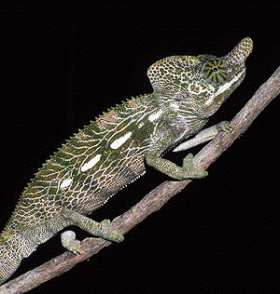July 11, 2008 feature
Exotic Chameleon Spends Most of its Life as an Egg

(PhysOrg.com) -- Scientists have discovered a chameleon species that spends a good two-thirds of its life inside an egg: Furcifer labordi lives about 8-9 months as an embryo, and has a post-hatching lifespan of just 4-5 months. As far as the scientists know, this strange life history is unique among all land vertebrates, and may help researchers better understand how certain ecological and hormonal factors influence life history evolution.
The small F. labordi lives in the extremely arid southwest region of Madagascar. The desert-like, spiny-forest area experiences a long dry season from March through November, and a rainy season between December and February. This harsh, variable environment may be one of the reasons for the odd life history of F. labordi.
As scientists Kristopher Karsten, et al., describe in a recent issue of PNAS, F. labordi’s eggs hatch in November, at the start of the rainy season. The creatures grow extremely quickly, with males increasing their body mass by more than 4% per day. By January, the juveniles become full-grown adults. The females lay their eggs in February, and then, quite abruptly, the entire F. labordi adult species dies out by the end of March. Between April and October, the species only exists inside well-hidden eggs.
Of the nearly 30,000 species of tetrapods (four-limbed vertebrates), none has such a short post-hatching lifespan, such a rapid growth rate, or spends the majority of its life cycle inside an egg like F. labordi. As the scientists explain, the chameleon’s unique characteristics are more reminiscent of ephemeral insects or aquatic vertebrates than terrestrial tetrapods.
“I think the most exciting thing to come out of this paper is that we've identified this really bizarre system, a short-lived chameleon, that is closely related to other species that have life histories more like what we expect from a typical tetrapod,” Karsten, of Oklahoma State University, told PhysOrg.com. “This presents an ideal system to explore evolutionary questions in a comparative framework.”
Despite data from five seasons of field studies, the researchers say that it’s still unclear as to why the chameleon lives this way. One hypothesis is that the high climatic variability and unpredictability forces the animals to shorten their life histories. They point out that many Malagasy mammals (those that live on the island of Madagascar) differ from their close relatives in more stable environments by exhibiting extremely short-lived or long-lived life histories to cope.
As part of a possible coping mechanism, the F. labordi embryos are presumed to exist in a state of diapause for their first several months, a dormant condition where the embryos delay growth. Up until the rainy season, the embryos grow extremely slowly during cool temperatures, and only resume normal development when the warm rainy season approaches before they hatch.
As prolonged as their embryonic growth is, the adult chameleons appear to quickly age and die just as naturally. The scientists observed that, by February, adults exhibited typical age-related deterioration, such as reduced mass, slower locomotion, and reduced strength, which caused several radio-tracked chameleons to fall from trees. The researchers also discovered three- and four-month-old individuals that were dead of unknown causes, with no signs of predation or mutilation.
Another explanation of such an odd life history suggests a hormonal – and, likewise, behavioral – influence. F. labordi may have high levels of androgens, which are associated with aggression, and may also participate in physically intense combat and agonistic courtship. If its androgens are high (due to a physically intense social system), this could lead to immune suppression, which might increase adult mortality relative to juveniles. As the scientists note, high adult mortality often leads to the evolution of short life spans and early age of reproduction.
But despite its unique life history, F. labordi still conforms to standard theory: it has the normal combination of small size, rapid growth, early reproductive age, and high adult mortality. It just exhibits these characteristics in a very extreme way.
The scientists hope that the discovery of this unique creature will offer researchers a new method for testing how various chameleon species, which in some ways are very similar, can evolve so differently. Such future studies may also help explain the ecological and hormonal factors of aging and longevity.
“We can not only start to explore why this type of life history evolved in this species, but also what the proximate mechanisms are of how these organisms grow, age, and reach senescence so quickly; things like genetics, hormones, environment, and the interactions between those variables,” Karsten said.
He added that the study may influence conservation strategies, too: “I think this study points out that, at least for some species, conservation efforts that utilize captive breeding propagation may not be beneficial. For several chameleon species, namely the perennial ones that we know about already, perhaps captive propagation would be a viable alternative. But for species like F. labordi, it would be wasted effort and resources. For this species, a conservation management plan for natural populations would be a better idea.”
More information: Karsten, Kristopher B.; Andriamandimbiarisoa, Laza N.; Fox, Stanley F.; and Raxworthy, Christopher J. “A unique life history among tetrapods: An annual chameleon living mostly as an egg.” 8980-8984, Proceedings of the National Academy of Sciences, July 1, 2008, vol. 1, no. 26.
Copyright 2008 PhysOrg.com.
All rights reserved. This material may not be published, broadcast, rewritten or redistributed in whole or part without the express written permission of PhysOrg.com.

















